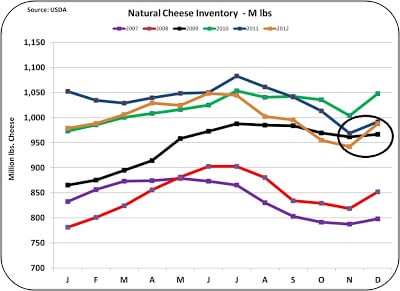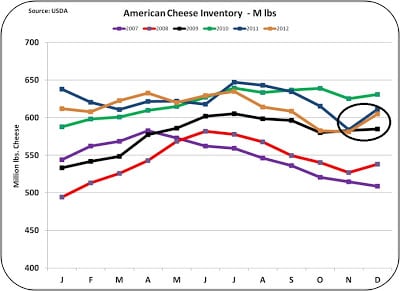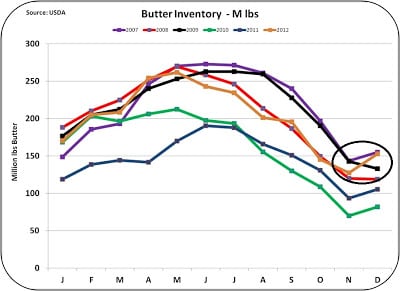Cheese showed some weakness in exports in November 2012 the last month for which data is available.

For the first time in 2012, exports fell below prior year levels. While the current level of exports is still robust, it is a significant decline from the levels of the second quarter. The impact of cheese exports has grown to have a major impact on U.S. cheese disappearance. Unlike domestic consumption which is relatively stable, exports can fluctuate widely from month to month.
In May 2012, cheese exports were 28 tonnes. By November, they had dropped to 19 tonnes - declining 34% in six months.

This has caused inventories for both Natural and American cheese to swell. The decline in exports that has occurred could not be responded to quickly by dairy producers and cheese manufacturers, so inventories have grown.
The impact on cheese prices has been dramatic. As of February 2, 2012, the CME cash price for cheese barrels was $1.54 per pound (lb). Two months ago, the price was over $2 per lb.
As can be expected, when inventories swell, prices go down. However, exports may quickly grow as the US$ has recently moved to a weaker position.

As of February 2, 2013, the Euro was as $1.36 (one Euro was worth 1.36 US$), the Australian Dollar was at $1.04 and the New Zealand Dollar was at $.85.
These are the major competing currencies for global dairy producers. They all indicate a weakening US$ which makes U.S. cheese less expensive on the international markets.
Butter

Butter has followed a similar pattern to cheese with inventories taking an unusually high upturn in December 2012. Butter was not having a strong export year like cheese, but nevertheless exports did take a dive in November 2012 and this has resulted in higher year end butter inventories.
More supply and lower demand have caused butter prices to take a significant drop. The NASS price for butter fell from $1.60/lb in December to $1.50 in January 2013.
How will the first quarter of 2013 go?
The fundamentals of an improving U.S. and world economy are favorable for consumption of dairy products. Also, the weak US$ makes U.S. products attractively priced in the international markets. However, improved producer milk prices will take a little time.
The current futures price for March Class III milk is $16.98 per hundredweight (cwt). The excess stocks will have to be depleted before milk prices can raise. With high feed prices and lower milk prices, the next few months look financially difficult.
You can see John's month-to-month US dairy commodity breakdowns at his blog, MilkPrice.
